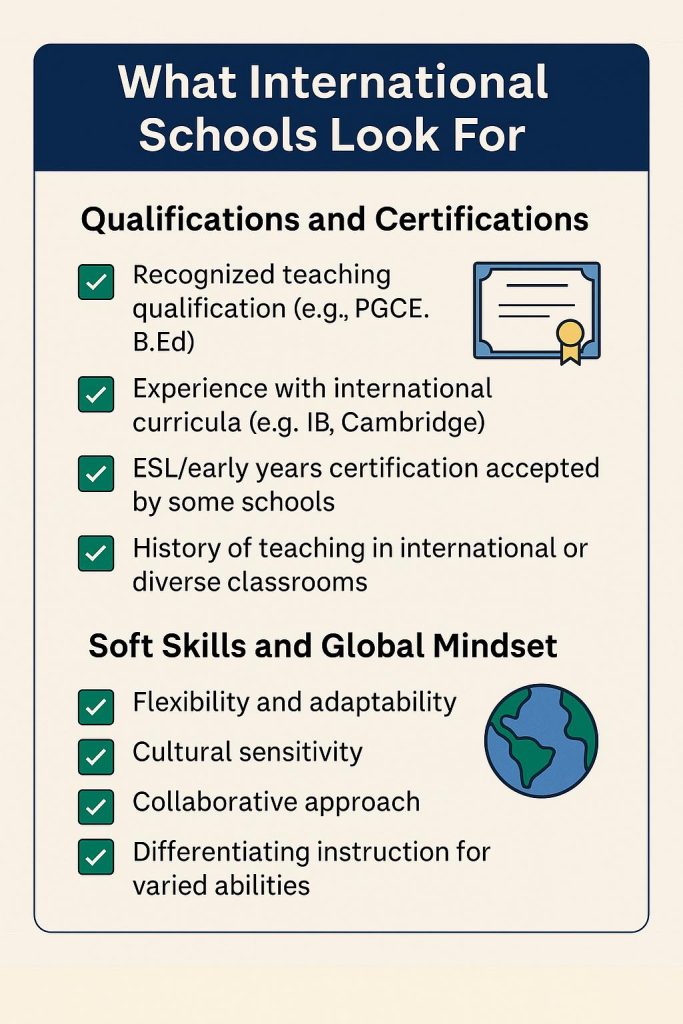Teaching abroad holds undeniable appeal—new cultures, rewarding classroom experiences, and the chance to make a global impact. But for many educators, the process of securing an international role can feel overwhelming. From navigating visa paperwork to understanding what schools in different regions actually want, it’s easy to feel unsure about where to begin—or how to stand out.
Our guide is designed to help you take a confident, informed approach to landing your ideal teaching job abroad. Whether you’re a recent graduate exploring your options or a seasoned educator seeking a fresh challenge, we’ll walk you through the key steps—from choosing the right destination to preparing for interviews and reviewing offers—so you can make decisions that align with your professional goals and lifestyle.
Understand What International Schools Are Looking For
Before you begin applying, it’s essential to understand what makes a candidate stand out in the global education market. International schools—while varied in size, curriculum, and ethos—tend to prioritise a mix of solid credentials and soft skills.

Checklist showing essential traits for international teachers: PGCE, IB experience, cultural adaptability, etc.
Qualifications and Certifications
Most reputable international schools expect candidates to hold a recognised teaching qualification such as a PGCE, B.Ed, or state teaching licence. For ESL or early years roles, a TEFL, TESOL, or CELTA may suffice, but increasingly, schools prefer candidates with experience in established international curricula like the IB, Cambridge, or American programmes. Experience teaching in multicultural environments or international schools is also a strong asset.
Soft Skills and Global Mindset
Teaching abroad isn’t just about delivering lessons—it’s about navigating cultural differences, adapting to new systems, and building relationships with students and families from all over the world. Schools value educators who demonstrate flexibility, resilience, cultural sensitivity, and a collaborative mindset. Being able to differentiate instruction and manage a classroom with varied language abilities is often essential, particularly in large urban schools or emerging markets.
Choose the Right Country and School Type for You
Not all international teaching jobs are created equal. What feels like a dream role for one person might be completely unsuitable for another. Taking time to reflect on your priorities will help you avoid costly or stressful surprises later on.

World map highlighting top destinations for international teachers with icons for salary, lifestyle, and benefits
Matching Your Priorities
Start by identifying what matters most to you—whether it’s salary, work-life balance, professional development, travel opportunities, or family support. For example, while schools in the Middle East often offer tax-free salaries and generous benefits, others in Southeast Asia may provide a more laid-back lifestyle with lower living costs but modest pay. Don’t forget to factor in language barriers, healthcare systems, and local culture when shortlisting destinations.
Types of International Schools
International schools come in many forms. Some are non-profit, mission-driven institutions with strong reputations and long-established curricula. Others may be for-profit schools, sometimes operated by larger groups or franchises. In some regions, “international” schools are primarily attended by local students and may differ significantly in resources and teaching expectations. Consider whether you’d prefer a boarding school, a bilingual environment, or a large chain school with potential for internal mobility. Each setting offers distinct challenges and rewards.
Build a Compelling Application Package
Once you’ve narrowed down where and what kind of school you’d like to work in, it’s time to craft an application that speaks to what international schools are actually looking for. Your paperwork should be polished, purposeful, and easy to review—especially in a highly competitive market.

Teacher working on building their digital portfolio
Tailored CV and Cover Letter
Avoid sending generic applications. Your CV should highlight international or cross-cultural experience, subject specialisms, curriculum knowledge (IB, Cambridge, etc.), and measurable impact—such as student growth data or leadership roles. Your cover letter should be short but purposeful, showing an understanding of the school’s values and how your background aligns with its mission.
Strong References
Schools almost always request references from your most recent line manager or school leadership. Where possible, include referees who can comment on your teaching style, classroom management, and professional conduct. Make sure references are prepared in advance and contactable by email (and sometimes phone).
Portfolio and Supporting Documents
Include copies of your qualifications, teaching licence, and transcripts—all neatly organised in a single digital folder. Some schools also appreciate examples of lesson plans, student work, or CPD certificates. If you’re applying through a recruitment agency or portal, ensure all documents are up to date and formatted consistently.
Prepare for the Interview Process
Once your application makes it through the shortlist, the interview stage is where you bring your professional story to life. It’s not just about answering questions—it’s about demonstrating your fit, mindset, and readiness to join a new school community abroad.

Video call, demo lesson, and school panel discussion are three common interview scenarios
Common Interview Formats
Most international schools now conduct initial interviews via video call, often with senior leaders or HR teams across different time zones. You may encounter panel interviews, scenario-based questions, or even be asked to deliver a demo lesson virtually or in person. If you’re applying through a job fair or agency, you might face multiple interviews over a few days.
Interview Best Practices
Be prepared to speak clearly about your teaching philosophy, experience with specific curricula, and how you manage a diverse classroom. Schools may also ask about safeguarding protocols or how you handle parent communication. Do your homework—research the school thoroughly and prepare thoughtful questions about staff support, onboarding, and school culture. This shows genuine interest and helps you assess whether the school is the right fit for you.
Review the Offer Carefully Before Accepting
Receiving an offer is exciting—but don’t rush into signing the contract. Take the time to review the details thoroughly to ensure the position aligns with your expectations, lifestyle, and long-term goals.
Understand the Contract
Look beyond the salary figure. Examine what’s included in the package: housing allowance or accommodation, flights, relocation support, medical insurance, and end-of-contract bonuses. Pay close attention to working hours, teaching load, holiday entitlements, and any non-teaching duties. A seemingly generous salary can quickly diminish if key benefits are missing or local costs are high.
Turning Ambition into Action
Landing your dream teaching job abroad takes more than a polished CV—it’s about knowing where to look, what questions to ask, and how to align your skills with the right opportunities. With thoughtful planning and a willingness to adapt, you can build a fulfilling teaching career in some of the world’s most vibrant and rewarding international settings.
Start with what matters most to you—be it professional growth, cultural experience, or lifestyle—and let that guide your choices. And when you’re ready to explore trusted opportunities, curated resources, and educator support networks, AISL Mall is here to help you take the next step.








